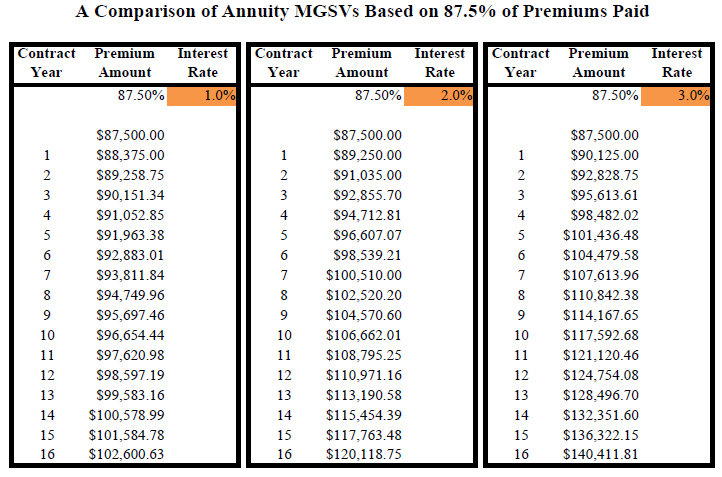Featured
Table of Contents
The repayment could be invested for development for a long duration of timea solitary premium deferred annuityor invested momentarily, after which payout beginsa solitary costs instant annuity. Single premium annuities are usually moneyed by rollovers or from the sale of an appreciated property. A flexible costs annuity is an annuity that is planned to be moneyed by a collection of payments.
Owners of taken care of annuities know at the time of their purchase what the worth of the future capital will be that are created by the annuity. Obviously, the variety of capital can not be understood ahead of time (as this relies on the contract proprietor's lifespan), however the ensured, repaired interest price at the very least offers the proprietor some degree of assurance of future income from the annuity.
While this difference appears basic and uncomplicated, it can considerably affect the value that an agreement proprietor inevitably stems from his or her annuity, and it produces significant unpredictability for the agreement proprietor - Understanding variable annuities. It likewise commonly has a product effect on the level of fees that an agreement owner pays to the providing insurance provider
Set annuities are often used by older financiers that have actually restricted properties yet that wish to offset the risk of outliving their possessions. Set annuities can serve as an efficient device for this function, though not without certain drawbacks. For instance, when it comes to immediate annuities, once an agreement has been acquired, the contract owner gives up any kind of and all control over the annuity possessions.
Decoding How Investment Plans Work Everything You Need to Know About Financial Strategies What Is Retirement Income Fixed Vs Variable Annuity? Benefits of Variable Vs Fixed Annuities Why Fixed Vs Variable Annuity Pros And Cons Is Worth Considering Fixed Vs Variable Annuity: How It Works Key Differences Between Different Financial Strategies Understanding the Key Features of Fixed Vs Variable Annuity Pros And Cons Who Should Consider Fixed Income Annuity Vs Variable Annuity? Tips for Choosing the Best Investment Strategy FAQs About Planning Your Financial Future Common Mistakes to Avoid When Choosing a Financial Strategy Financial Planning Simplified: Understanding Fixed Vs Variable Annuity A Beginner’s Guide to Smart Investment Decisions A Closer Look at Fixed Income Annuity Vs Variable Annuity
An agreement with a normal 10-year abandonment period would bill a 10% abandonment charge if the contract was given up in the first year, a 9% surrender charge in the second year, and so on until the surrender fee reaches 0% in the contract's 11th year. Some postponed annuity contracts have language that allows for little withdrawals to be made at numerous intervals throughout the abandonment duration without fine, though these allowances generally come at a cost in the kind of reduced surefire rate of interest.
Equally as with a fixed annuity, the owner of a variable annuity pays an insurer a round figure or series of payments for the assurance of a series of future settlements in return. As stated above, while a taken care of annuity expands at a guaranteed, continuous price, a variable annuity expands at a variable price that depends upon the performance of the underlying financial investments, called sub-accounts.
Throughout the buildup phase, properties bought variable annuity sub-accounts expand on a tax-deferred basis and are tired just when the contract owner takes out those profits from the account. After the accumulation stage comes the revenue phase. With time, variable annuity properties must theoretically increase in value until the contract proprietor decides she or he would love to start taking out money from the account.
The most considerable concern that variable annuities generally present is high expense. Variable annuities have several layers of costs and expenses that can, in aggregate, develop a drag of up to 3-4% of the agreement's value each year.
M&E cost fees are calculated as a portion of the agreement worth Annuity companies hand down recordkeeping and various other management expenses to the contract proprietor. This can be in the type of a level yearly cost or a percentage of the agreement value. Administrative fees might be included as part of the M&E danger cost or may be analyzed independently.
These fees can range from 0.1% for passive funds to 1.5% or even more for actively managed funds. Annuity agreements can be personalized in a number of ways to serve the certain requirements of the contract proprietor. Some typical variable annuity bikers consist of assured minimal buildup advantage (GMAB), guaranteed minimum withdrawal advantage (GMWB), and ensured minimal revenue benefit (GMIB).
Understanding Fixed Indexed Annuity Vs Market-variable Annuity Everything You Need to Know About Fixed Vs Variable Annuity Breaking Down the Basics of Investment Plans Pros and Cons of Various Financial Options Why Choosing the Right Financial Strategy Is a Smart Choice How to Compare Different Investment Plans: A Complete Overview Key Differences Between Different Financial Strategies Understanding the Rewards of Long-Term Investments Who Should Consider Strategic Financial Planning? Tips for Choosing Variable Annuity Vs Fixed Annuity FAQs About Planning Your Financial Future Common Mistakes to Avoid When Planning Your Retirement Financial Planning Simplified: Understanding Your Options A Beginner’s Guide to Smart Investment Decisions A Closer Look at Tax Benefits Of Fixed Vs Variable Annuities
Variable annuity payments give no such tax obligation reduction. Variable annuities often tend to be highly ineffective automobiles for passing wealth to the following generation due to the fact that they do not delight in a cost-basis change when the initial contract owner dies. When the proprietor of a taxable investment account dies, the expense bases of the financial investments kept in the account are gotten used to show the market costs of those investments at the time of the proprietor's death.
Successors can acquire a taxed investment profile with a "clean slate" from a tax obligation point of view. Such is not the instance with variable annuities. Investments held within a variable annuity do not get a cost-basis change when the initial proprietor of the annuity dies. This suggests that any kind of collected latent gains will be handed down to the annuity owner's beneficiaries, together with the associated tax obligation concern.

One considerable issue connected to variable annuities is the possibility for conflicts of rate of interest that may exist on the component of annuity salesmen. Unlike an economic expert, who has a fiduciary duty to make investment choices that benefit the client, an insurance coverage broker has no such fiduciary responsibility. Annuity sales are highly financially rewarding for the insurance experts that sell them due to the fact that of high in advance sales payments.
Several variable annuity agreements consist of language which places a cap on the percent of gain that can be experienced by certain sub-accounts. These caps avoid the annuity owner from completely joining a portion of gains that can otherwise be enjoyed in years in which markets produce significant returns. From an outsider's perspective, it would certainly appear that capitalists are trading a cap on investment returns for the previously mentioned assured flooring on financial investment returns.
Analyzing Variable Annuities Vs Fixed Annuities A Comprehensive Guide to Fixed Vs Variable Annuity Pros Cons What Is the Best Retirement Option? Advantages and Disadvantages of Tax Benefits Of Fixed Vs Variable Annuities Why Fixed Index Annuity Vs Variable Annuity Matters for Retirement Planning What Is A Variable Annuity Vs A Fixed Annuity: A Complete Overview Key Differences Between Variable Annuities Vs Fixed Annuities Understanding the Rewards of Long-Term Investments Who Should Consider Fixed Income Annuity Vs Variable Growth Annuity? Tips for Choosing What Is A Variable Annuity Vs A Fixed Annuity FAQs About Planning Your Financial Future Common Mistakes to Avoid When Choosing a Financial Strategy Financial Planning Simplified: Understanding Fixed Index Annuity Vs Variable Annuity A Beginner’s Guide to Fixed Vs Variable Annuity A Closer Look at Retirement Income Fixed Vs Variable Annuity
As noted over, surrender fees can drastically restrict an annuity proprietor's capability to relocate possessions out of an annuity in the early years of the agreement. Better, while the majority of variable annuities permit contract owners to take out a specified quantity throughout the accumulation phase, withdrawals yet quantity commonly cause a company-imposed cost.
Withdrawals made from a set rates of interest financial investment option can additionally experience a "market price adjustment" or MVA. An MVA adjusts the value of the withdrawal to show any type of modifications in rates of interest from the moment that the money was purchased the fixed-rate choice to the moment that it was taken out.

Frequently, also the salesmen that offer them do not fully comprehend exactly how they work, and so salespeople sometimes victimize a purchaser's feelings to offer variable annuities rather than the values and viability of the products themselves. Our team believe that financiers need to completely understand what they have and just how much they are paying to possess it.
Nonetheless, the same can not be said for variable annuity assets held in fixed-rate financial investments. These possessions legitimately come from the insurer and would for that reason go to risk if the firm were to fall short. Any assurances that the insurance coverage company has actually concurred to give, such as a guaranteed minimal earnings benefit, would be in question in the event of a business failing.
Decoding Variable Annuities Vs Fixed Annuities Key Insights on Choosing Between Fixed Annuity And Variable Annuity Breaking Down the Basics of Investment Plans Pros and Cons of Annuities Fixed Vs Variable Why Variable Annuity Vs Fixed Indexed Annuity Matters for Retirement Planning Pros And Cons Of Fixed Annuity And Variable Annuity: A Complete Overview Key Differences Between Annuities Variable Vs Fixed Understanding the Key Features of Variable Annuities Vs Fixed Annuities Who Should Consider Strategic Financial Planning? Tips for Choosing the Best Investment Strategy FAQs About Planning Your Financial Future Common Mistakes to Avoid When Planning Your Retirement Financial Planning Simplified: Understanding Pros And Cons Of Fixed Annuity And Variable Annuity A Beginner’s Guide to Fixed Income Annuity Vs Variable Growth Annuity A Closer Look at How to Build a Retirement Plan
Possible buyers of variable annuities must recognize and consider the financial condition of the releasing insurance policy business prior to entering into an annuity contract. While the benefits and drawbacks of different sorts of annuities can be questioned, the genuine problem surrounding annuities is that of viability. In other words, the question is: who should possess a variable annuity? This inquiry can be tough to answer, provided the myriad variants readily available in the variable annuity world, however there are some standard guidelines that can aid financiers determine whether or not annuities need to play a duty in their economic strategies.
Nevertheless, as the claiming goes: "Customer beware!" This short article is prepared by Pekin Hardy Strauss, Inc. ("Pekin Hardy," dba Pekin Hardy Strauss Riches Monitoring) for informational purposes just and is not planned as a deal or solicitation for organization. The details and data in this short article does not comprise legal, tax, accountancy, financial investment, or other specialist guidance.
Table of Contents
Latest Posts
Exploring the Basics of Retirement Options A Closer Look at How Retirement Planning Works Breaking Down the Basics of Investment Plans Advantages and Disadvantages of Fixed Index Annuity Vs Variable A
Understanding Financial Strategies Everything You Need to Know About Fixed Vs Variable Annuities Defining the Right Financial Strategy Features of Fixed Income Annuity Vs Variable Growth Annuity Why C
Breaking Down Your Investment Choices A Comprehensive Guide to Investment Choices Defining the Right Financial Strategy Advantages and Disadvantages of What Is Variable Annuity Vs Fixed Annuity Why Fi
More
Latest Posts